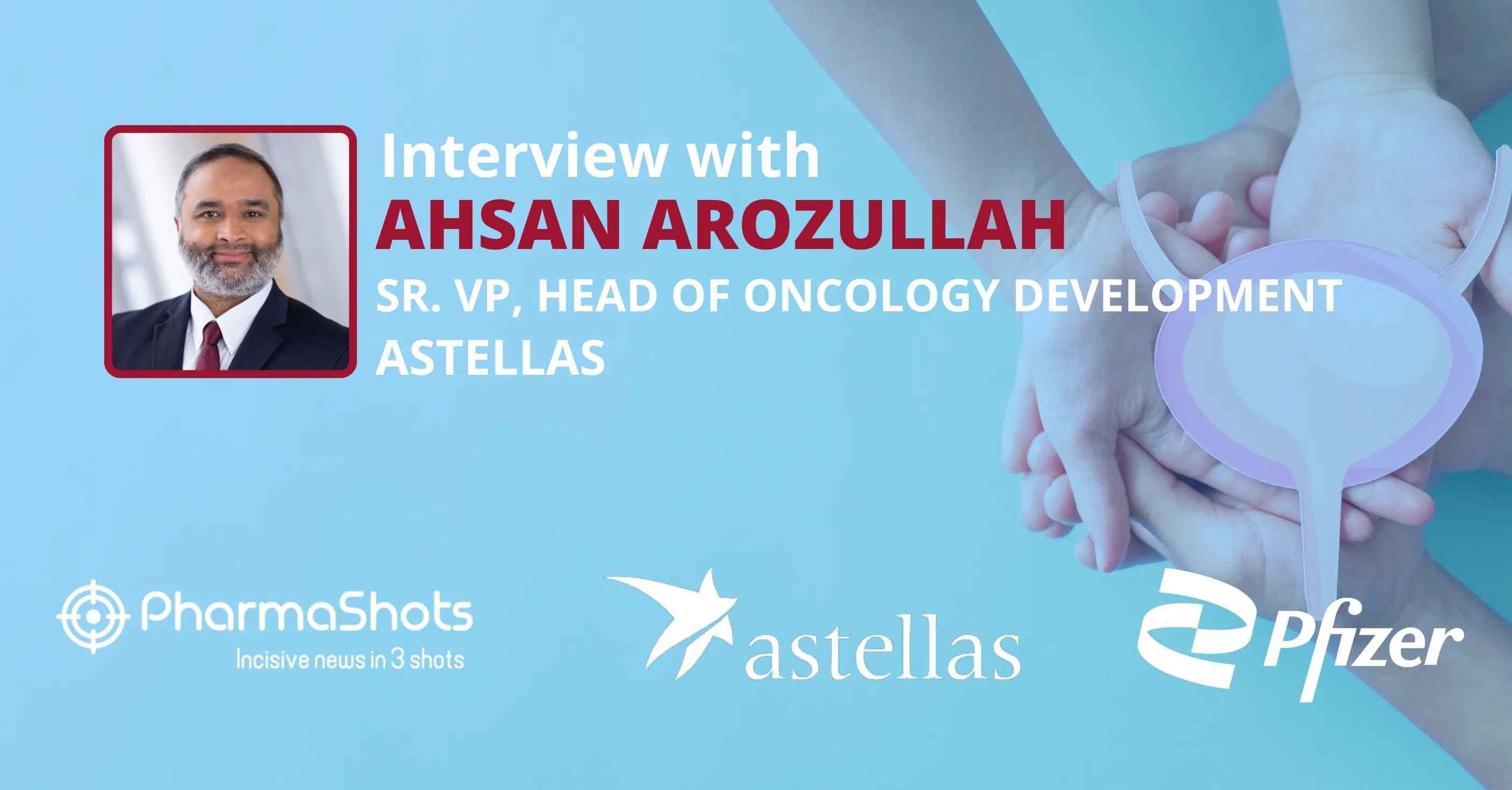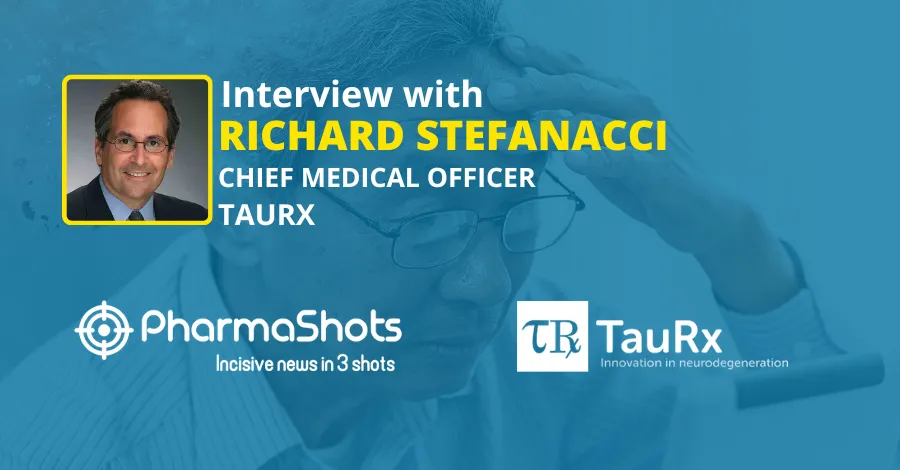
Dr. Jay Backstrom shares insights from the Phase II TOPAZ trial for the treatment of SMA
Shots:
-
Dr. Jay Backstrom in an engaging conversation with PharmaShots, shares the highlights of the P-II Topaz trial designed to evaluate the safety and efficacy of apitegromab for the treatment of Spinal Muscle Atrophy (Type 2 & 3)
-
With the potential to transform care in SMA by directly addressing progressive muscle weakness, apitegromab aims to fulfill the unmet need for improved and sustained muscle function
-
Following a positive TOPAZ P-II POC trial, Scholar Rock looks forward to sharing the topline results of SAPPHIRE in 2024, which is a randomized, double-blind, placebo-controlled trial
Saurabh: Would you please highlight the details of the Phase 2 TOPAZ Trial in patients with Nonambulatory Spinal Muscular Atrophy?
Jay: TOPAZ is a proof-of-concept Phase 2 study designed to evaluate the safety and efficacy of apitegromab in a broad range of patients with Type 2 and 3 SMA. TOPAZ included three cohorts of patients, including those who were ambulatory (Cohort 1) and nonambulatory (Cohorts 2 and 3). I’ll focus on sharing the details for the nonambulatory patients from Cohorts 2 and 3 from the study, which represent the main efficacy population of our pivotal Phase 3 trial, SAPPHIRE.
Cohort 2 included 15 patients ages 5-21, with Type 2 or nonambulatory Type 3 SMA, treated with 20mg/kg apitegromab, and who had received nusinersen therapy after the age of 5. Cohort 3 included 20 patients ages 2-12 with Type 2 SMA, who had received nusinersen before the age of 5 and who were randomized to 2 doses, either 2 or 20mg/kg apitegromab.
The primary efficacy endpoint for the study was mean change from baseline in motor function as measured by Hammersmith Functional Motor Scale Expanded (HFMSE for short).
Over a 36-month treatment period, data showed substantial and sustained gains from baseline in HFMSE scores. A similar trend was observed for upper limb function as measured by RULM, a secondary endpoint. RULM measures the ability to perform activities of daily living such as pushing a button, opening a container, or lifting a cup. The improvement in RULM seen at 12 months continued to strengthen over time and was maintained over the entire 36-month period. Continued improvement in RULM is particularly meaningful to nonambulatory patients as they are limited in their ability to walk.
Importantly, our updated data showed improvements in patient-reported outcomes measuring fatigue and the ability to perform daily activities and these improvements were consistent with the improvements in motor function across the 36 months of the study period.
Finally, the safety profile remains consistent with previous reports, and we observed a low discontinuation rate, with more than 90 percent of nonambulatory patients remaining on study, supporting the durability of treatment.
These results suggest that apitegromab has the potential to transform care in SMA by directly addressing progressive muscle weakness, further strengthening our confidence in apitegromab’s therapeutic potential for patients. We continue to assess that potential through our ongoing pivotal Phase 3 SAPPHIRE registrational trial.
Saurabh: How do the new Phase 2 data presented by Dr. Thomas Crawford support the therapeutic potential of apitegromab in addressing persistent weakness and motor functioning in patients with SMA?
Jay: Improving and sustaining muscle function remains a persistently unmet need within the SMA community. In a recent Cure SMA community survey, 97% of participants hoped that new therapies would address gaining muscle strength. Other priorities include a reduction in fatigue (83%, achieving new motor function (89%), stabilizing motor function (91%), and improving activities of daily living (92%). The survey also found that what may seem like minimal gains in strength, like eating soup or brushing one’s hair, translate to substantial gains in functional abilities. Current approved SMA therapies do not address underlying muscle atrophy and associated muscle weakness. In our view, selectively targeting myostatin can lead to increased muscle function and strength and has the potential to improve activities of daily living for people with SMA.
Our recently shared Phase 2 data demonstrate this potential. For example, over the 36-month treatment period, we observed, on average, a four-point increase in HFMSE scores from baseline. Additionally, over 80% of the patients achieved a one-point or better increase in HFMSE, and a slight majority of the patients achieved a three-point or better increase in HFMSE.
I’ll offer some context on what this can mean to a patient, which you can also hear about by listening to our recent investor call with leaders in the field of SMA. While a 3-point change has been shown to be clinically meaningful, patients and caregivers have reported that a 1 point improvement on HFMSE is considered meaningful, with the potential to considerably change the course of their day-to-day activities. These results further strengthen our confidence in apitegromab’s therapeutic potential for patients with SMA, as well as validate Scholar Rock’s unique approach to selectively inhibiting the pro- and latent forms of myostatin.
Saurabh: How does Scholar Rock's distinct method for specifically blocking the pro and latent versions of myostatin add to the drug's potential for treating SMA patients?
Jay: At Scholar Rock, we are laser-focused on how we can overcome the challenges that have plagued previous approaches to myostatin therapies. Traditional approaches have focused on targeting the “mature” growth factor or its receptors, which are difficult to differentiate and lead to unintended negative effects. We believe selective targeting of growth factors has the potential to treat many serious and under-addressed diseases, including SMA. Apitegromab, as a fully human monoclonal antibody, is designed to inhibit myostatin by selectively binding the pro- and latent myostatin in skeletal muscle.
Our therapeutic approach is rooted in strong preclinical evidence indicating that upstream targeting of structurally differentiated latent myostatin avoids undesirable off-target effects. As a result, we are proud to be the first and only company to demonstrate clinical proof-of-concept for a muscle-targeted treatment in SMA, as it brings us closer to our goal to potentially advance the standard of care for people with SMA.
Saurabh: Over the course of the 36-month treatment period, which treatment-emergent adverse events (TEAEs) were most frequently seen with apitegromab, and were they typically mild-to-moderate in severity?
Jay: We’re pleased to see that over 90% of nonambulatory patients remained on treatment, with our new Phase 2 data supporting apitegromab’s long-term durability of effect and consistent tolerability and safety profile. No new or serious safety risks were identified over 3 years of treatment in our Phase 2 clinical trial. Treatment-emergent adverse events (TEAEs) were mostly mild-to-moderate in severity, and generally consistent with the underlying patient population and background therapy. The five most common TEAEs were headache, pyrexia, COVID-19, nasopharyngitis, and upper respiratory tract infection. Deaths or other suspected unexpected serious adverse reactions or hypersensitivity reactions were not observed with apitegromab at 36 months. No patients displayed positive titers for apitegromab antibodies (ADA).
Saurabh: The Phase 3 SAPPHIRE registrational trial is currently underway. Could you provide an update on the progress of this trial, including the anticipated completion timeline, and the potential impact of the P-III trial's findings on the Phase 2 TOPAZ trial extension?
Jay: We are on track to complete enrollment of our registrational SAPPHIRE Phase 3 clinical trial in Q3 of this year. As a next step, our focus will be completing the trial and working with regulatory agencies to seek approval to potentially bring the first muscle-targeted treatment in SMA to patients.
The positive results of the TOPAZ Phase 2 proof-of-concept trial informed the design of SAPPHIRE to further study the therapeutic potential of apitegromab in SMA. Building on the strong foundation of TOPAZ, SAPPHIRE is a randomized, double-blind, placebo-controlled trial which will evaluate the safety and efficacy of apitegromab in nonambulatory patients with Types 2 and 3 SMA who are receiving SMN therapy (either nusinersen or risdiplam), with the primary efficacy endpoint evaluating the mean change from baseline in HFMSE score after 12 months of treatment.
Approximately 156 patients aged 2-12 years old are anticipated to be enrolled in the main efficacy population and these patients will be randomized 1:1:1 to receive for 12 months either apitegromab 10 mg/kg, apitegromab 20 mg/kg, or placebo by intravenous (IV) infusion every 4 weeks. An exploratory population of approximately 48 patients aged 13-21 years old will also separately be evaluated, where patients will be randomized 2:1 to receive either apitegromab 20 mg/kg or placebo.
We look forward to sharing the topline results of SAPPHIRE, which are anticipated in 2024.
Saurabh: How do the results of the Phase 2 TOPAZ study and the therapeutic potential of apitegromab support Scholar Rock's goal to raise the bar for treating people with spinal muscular atrophy?
Jay: Since our inception, we have been focused on changing the lives of people living with devastating diseases where selective growth factor-targeted drugs can play a transformational role in addressing significant unmet needs, including neuromuscular disease and cancer.
By staying grounded in our unique scientific approach and collaborating with community members who are impacted by these diseases every day, we look to advance the standard of care for people living with SMA as quickly as we can. Looking at the current treatment landscape in SMA, and based on the feedback we have received from clinicians and their patients, there is a need for combination approaches to address the various systems and pathways affected by SMA.
Should apitegromab be approved by the FDA, it would be the first muscle-targeted treatment in SMA, adding a new treatment option that could work synergistically with other SMN upregulatory therapies approved for the treatment of SMA in an effort to address the full spectrum of the disease.
Saurabh: How is Scholar Rock’s SMA treatment better over existing SMA treatments whether across modalities and what is that unmet need which others fail to address and Scholar Rocks molecule addresses?
Jay: The innovation that led to the SMN upregulators is to be celebrated, as these treatments have changed the natural history of SMA. However, there is significant room for further improvement and there is need for additional treatments, particularly muscle-targeted therapies, to restore and maintain muscle function and help people living with SMA achieve greater independence.
We know through our research and our collaborations with experts, patients, and caregivers in the broader SMA community that there is a need for therapies that directly address muscle atrophy.
Apitegromab, if approved, is poised to be the first muscle-directed therapy for SMA that will complement, and not compete, with the currently approved SMN upregulators.
Related Post: Marija Geertsen shares highlights of the data presented at the 65th AHS Annual Meeting
Image Source: Canva
About the Author

Dr. Jay Backstrom
Dr. Jay Backstrom joined Scholar Rock in October 2022 as President & CEO. He is an industry veteran with over 30 years of experience in clinical research and development. Prior to Scholar Rock, he served as Executive Vice President, Research and Development at Acceleron Pharma, from December 2019 through its acquisition by Merck in 2021. Previously, he served as the Chief Medical Officer and Head of Global Regulatory Affairs for Celgene Corporation and spent more than a decade at the company during a time of significant pipeline expansion and revenue growth. Prior to Celgene, Jay served as the Vice President, Global Medical Affairs and Safety at Pharmion and held industry roles at Quintiles, Hoechst Marion Roussel and Marion Merrell Dow. Prior to joining industry, he served as staff physician and medical director of the Samuel U. Rodgers Community Health Center in Kansas City, Missouri. Jay holds an M.D. from Temple University School of Medicine, received post-graduate training in Internal Medicine at Temple University Hospital, and holds an MPH. from St. Louis University School of Public Health.
Tags

Saurabh is a Senior Content Writer at PharmaShots. He is a voracious reader and follows the recent trends and innovations of life science companies diligently. His work at PharmaShots involves writing articles, editing content, and proofreading drafts. He has a knack for writing content that covers the Biotech, MedTech, Pharmaceutical, and Healthcare sectors.













